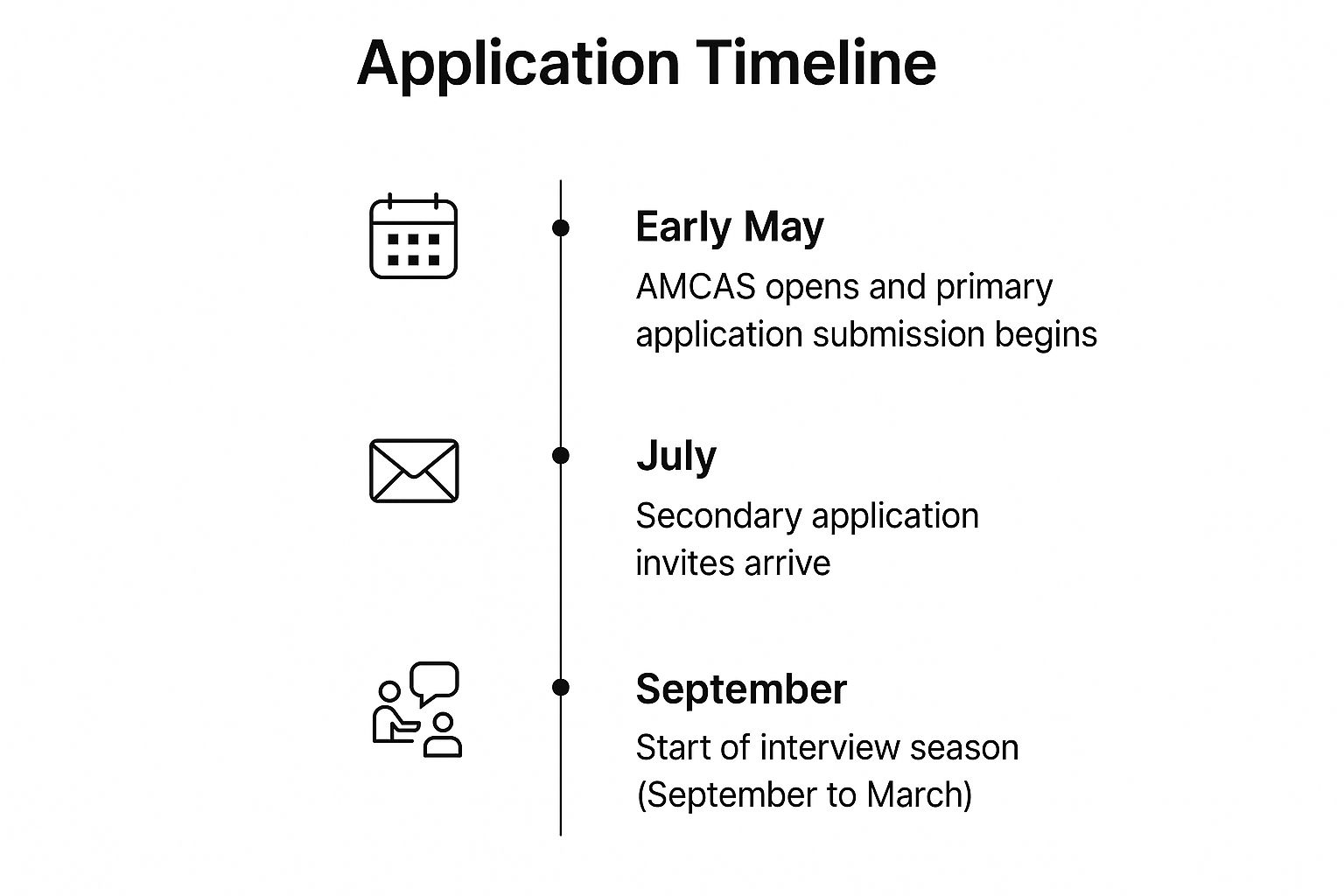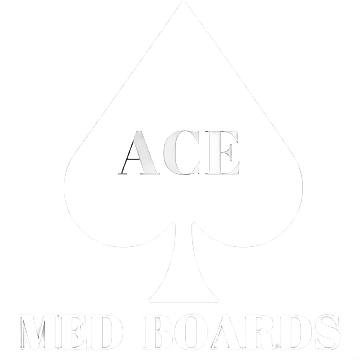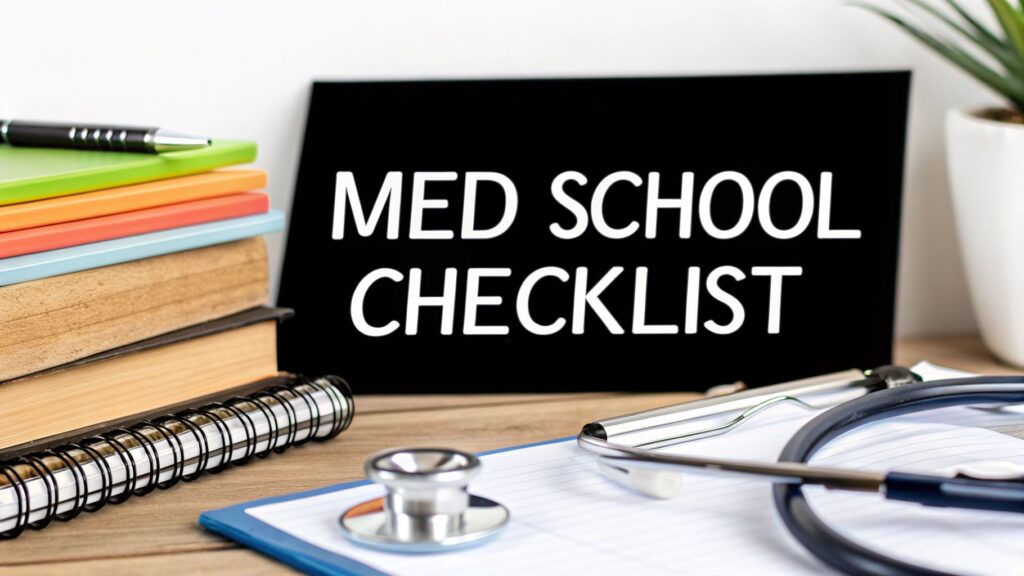The journey to medical school is a marathon, not a sprint, demanding meticulous planning and strategic execution. While the goal is clear–earning that coveted acceptance letter–the path is paved with countless details, deadlines, and decisions. This is more than just a list of tasks; it's a comprehensive roadmap designed to navigate the complexities of the application process. We've crafted this definitive medical school application checklist to move beyond generic advice, offering actionable insights and strategic frameworks for each critical component.
From decoding the nuances of the MCAT and achieving academic excellence to crafting a compelling personal narrative and securing impactful letters of recommendation, this guide provides the structure you need. It will break down everything from your primary AMCAS or AACOMAS application to the secondary essays that follow. As you map your path to medicine, exploring various funding opportunities like healthcare grants can also be a crucial step for managing the significant financial investment.
Consider this your strategic blueprint for transforming a good application into an unforgettable one. We will ensure every element, from your coursework to your extracurriculars, aligns to present the strongest possible case for your admission. By following this detailed checklist, you will be well-equipped to manage the demanding timeline and submit a polished application that truly reflects your potential as a future physician. This guide is your first step toward building a standout profile that captures the attention of admissions committees.
1. MCAT Score and Preparation
The Medical College Admission Test (MCAT) is more than just an exam; it's a critical component of your medical school application that provides a standardized measure of your academic readiness. This challenging, multiple-choice test assesses your problem-solving skills, critical thinking abilities, and foundational knowledge in the natural, behavioral, and social sciences. Admissions committees use your score to gauge your potential to succeed in their rigorous curriculum, making it a cornerstone of any competitive application.

A strong MCAT score can significantly strengthen your entire profile. Scores range from 472 to 528, and a score of 510 or higher is generally considered competitive for most allopathic (M.D.) medical schools. However, this varies widely based on the institution's prestige and applicant pool.
- Top-Tier Programs: Highly competitive schools often see median scores much higher. For example, Harvard Medical School has a median MCAT of 520, while the Mayo Clinic Alix School of Medicine has a median of 521.
- State Schools: Public and state-affiliated schools may have slightly more accessible median scores, often falling within the 510-512 range.
Actionable Preparation Strategy
Your approach to the MCAT should be a dedicated, months-long campaign, not a last-minute sprint. Timing is crucial; aim to take the exam by the spring of your application year. This ensures your score is available when you submit your primary application in June, a key step in a successful medical school application checklist.
Key Insight: Treat your MCAT preparation like a demanding science course. Allocate specific, non-negotiable hours each week for content review, practice questions, and full-length exam simulations.
To maximize your performance, follow these structured steps:
- Create a Study Timeline: Dedicate 3-6 months for focused preparation. A 300-500 hour study plan is a common and effective target.
- Take a Diagnostic Test: Before you begin, take a full-length practice exam to establish a baseline. This will immediately highlight your content weaknesses and strengths.
- Focus on Weak Areas: Use your diagnostic results to structure your study plan, dedicating more time to subjects where you scored lowest.
- Simulate Exam Conditions: Take multiple full-length practice tests under timed, realistic conditions. This builds endurance and helps you manage the test's grueling 7.5-hour length.
2. Undergraduate GPA and Course Requirements
Your undergraduate Grade Point Average (GPA) is a direct reflection of your academic consistency and ability to handle a demanding scientific workload. Alongside the MCAT, your GPA is one of the most significant quantitative metrics on your application. Admissions committees scrutinize both your cumulative GPA (all courses) and your science GPA (often called BCPM: Biology, Chemistry, Physics, and Math) to assess your academic foundation.
A high GPA demonstrates not just intelligence but also discipline, time management, and resilience over several years. This sustained performance is a strong predictor of your capacity to thrive in the fast-paced, high-volume environment of medical school.
The standard for a competitive GPA is high, and it varies by institution. While there's no absolute cutoff, certain benchmarks can guide you.
- Average Matriculant: According to the AAMC, the average cumulative GPA for students who matriculated into U.S. medical schools is around 3.75, with a science GPA of approximately 3.68.
- Top-Tier Programs: Highly-ranked schools often have even higher averages. For instance, Johns Hopkins University School of Medicine reports a median undergraduate GPA of 3.94 for its entering class.
- GPA Repair: For applicants with lower GPAs, post-baccalaureate programs or a Special Master's Program (SMP) can offer a second chance to demonstrate academic readiness.
Actionable Preparation Strategy
Building a strong GPA is a marathon, not a sprint, starting from your first day of college. Completing the necessary prerequisite courses is non-negotiable, and how and where you take them also matters. These courses, typically including a year each of biology, general chemistry, organic chemistry, and physics with labs, plus English and math, form the academic bedrock of your pre-medical journey.
Key Insight: Admissions committees look for an upward trend. A lower GPA in your first year followed by steady improvement can be viewed more favorably than a high GPA that declines over time, as it shows growth and maturity.
To build a competitive academic record for your medical school application checklist, implement these strategies:
- Prioritize Prerequisite Courses: Take these foundational science courses at a four-year university whenever possible, as this is often viewed more favorably than taking them at a community college.
- Aim for a 3.7+ GPA: Strive to maintain a cumulative and science GPA of 3.7 or higher to be a competitive applicant at a wide range of medical schools.
- Balance Your Course Load: Don't overload yourself with difficult science courses in a single semester. A strategic, balanced schedule can protect your GPA and prevent burnout.
- Seek Help Early: If you find yourself struggling in a course, immediately utilize academic resources like tutoring centers, professor office hours, and study groups. Proactive measures are crucial to preventing a small stumble from impacting your overall GPA.
3. Clinical Experience and Patient Exposure
Clinical experience is the heart of a pre-medical student's journey, offering a direct window into the realities of patient care. It's more than just a box to check on your medical school application checklist; it demonstrates your commitment to medicine, your empathy for patients, and your understanding of the healthcare environment. Admissions committees look for sustained, meaningful interactions with patients to see if you have truly tested your desire to become a physician.

Quality clinical exposure shows you have witnessed both the rewarding and the challenging aspects of the profession. While there is no magic number of hours, most successful applicants have at least 150-200 hours of direct patient exposure. Consistency and the depth of your reflections are far more important than the sheer quantity of hours.
- High-Interaction Roles: Positions like EMT, CNA, or medical scribe offer immersive, hands-on experience and are highly valued.
- Volunteer Roles: Volunteering in a hospital, hospice, or free clinic provides valuable exposure to diverse patient populations and the inner workings of healthcare systems.
Actionable Preparation Strategy
Gaining clinical experience should be a long-term commitment that begins early in your pre-medical path. The goal is to build a portfolio of experiences that showcase your growth and solidify your motivations for pursuing medicine. Don't wait until the year you apply; start exploring opportunities as a freshman or sophomore.
Key Insight: Focus on the quality of your interactions, not just the quantity of your hours. Reflect deeply on what you see and learn, and be prepared to articulate how these experiences have shaped your understanding of medicine.
To build a strong clinical profile, follow these structured steps:
- Start Early and Be Consistent: Seek out opportunities and maintain them over a long period. A two-year commitment at one clinic is more impactful than two months at six different locations.
- Seek Diverse Settings: Try to gain experience in different environments, such as a large hospital, a small private clinic, or a community health center, to see various sides of medicine.
- Prioritize Direct Patient Contact: Look for roles where you directly interact with patients, whether it's taking vitals, transporting them, or simply talking with them at their bedside.
- Document and Reflect: Keep a detailed journal of your experiences. Note specific patient encounters, challenges you observed, and what you learned about the physician-patient relationship. This will be invaluable when writing your primary application and preparing for interviews.
4. Research Experience and Publications
Engaging in research demonstrates your scientific curiosity, analytical skills, and commitment to the principles of evidence-based medicine. While not a strict requirement for every medical school, substantive research experience is a powerful differentiator, particularly for top-tier programs and for applicants aspiring to careers in academic medicine. It shows admissions committees that you can think critically, test hypotheses, and contribute to the body of scientific knowledge that underpins medical practice.
A meaningful research experience can significantly elevate your application, providing you with unique stories and skills to discuss in your essays and interviews. The type of research can vary widely, from bench science to clinical studies.
- Top-Tier and Research-Intensive Programs: Schools like Johns Hopkins or Stanford often look for applicants with long-term, dedicated research involvement, sometimes leading to a poster presentation or a publication.
- Primary Care Focused Schools: While still valued, the emphasis may be less on basic science and more on clinical, public health, or community-based research that aligns with the school's mission.
Actionable Preparation Strategy
Your goal is to find a research opportunity that genuinely interests you and allows for meaningful contribution over a sustained period. Quality and depth trump quantity; a long-term commitment to one or two projects is far more impressive than brief stints in multiple labs. Start seeking opportunities early in your undergraduate career to allow time for growth and potential for a significant outcome.
Key Insight: The most important part of research isn't a publication; it's being able to intelligently and passionately discuss your project's hypothesis, your specific role, the challenges you faced, and what you learned from the process.
To secure a valuable research position, follow these structured steps:
- Identify Your Interests: Explore different fields. Do you prefer wet-lab benchwork, computational biology, clinical trials, or public health surveys?
- Seek Out Mentors: Reach out to professors at your university whose work aligns with your interests. Read their papers and send a personalized email expressing your curiosity about their research.
- Explore Formal Programs: Apply to structured summer research programs, such as those offered by the NIH (Summer Internship Program) or the NSF (Research Experiences for Undergraduates).
- Document Your Contributions: Keep a detailed log of your responsibilities and achievements. This will be invaluable when you fill out your primary application and prepare for interviews, making this a critical part of your medical school application checklist.
5. Letters of Recommendation Strategy
Strong letters of recommendation are far more than just a formality; they provide critical, third-party validation of your character, academic prowess, and suitability for a career in medicine. Admissions committees rely on these letters to gain a holistic view of you beyond your grades and test scores. A compelling letter can confirm the qualities you describe in your personal statement and highlight your potential to thrive in a demanding clinical and academic environment.
Most medical schools require a minimum of three letters, though some may accept up to five. The ideal collection of letters provides a well-rounded perspective on your abilities.
- Science Faculty: Typically, two letters from science professors who taught you in prerequisite courses (e.g., biology, chemistry, physics) are required. These letters validate your academic strength in the core sciences.
- Non-Science Faculty: A letter from a humanities, arts, or social science professor can showcase your intellectual curiosity and communication skills outside of STEM.
- Experience-Based Letters: A letter from a research mentor, physician you shadowed, or volunteer supervisor can speak directly to your hands-on skills, professionalism, and commitment to medicine.
Actionable Preparation Strategy
Securing powerful letters of recommendation begins long before you ask. It starts with building genuine, professional relationships with potential recommenders throughout your undergraduate years. Aim to identify your letter writers by the fall of your junior year to give them ample time and context.
Key Insight: When you request a letter, provide your recommender with a "packet" including your CV, personal statement draft, and a summary of your key experiences with them. This refreshes their memory and helps them write a detailed, personalized letter.
To ensure your letters add maximum value to your medical school application checklist, follow these structured steps:
- Build Relationships Early: Attend office hours, ask thoughtful questions in class, and show genuine interest in your professors' and mentors' work. A recommender who knows you well can write a much more impactful letter.
- Request in Advance: Give your recommenders at least two months of notice before your application deadline. A rushed request often results in a generic letter.
- Waive Your Right to View: Always waive your right to see your letters on the AMCAS application. This signals to admissions committees that you trust your recommender and that the letter is candid, which gives it more credibility.
- Follow Up Politely: Send a gentle reminder two to three weeks before the submission deadline to ensure everything is on track. Once submitted, send a thank-you note to show your appreciation.
6. Personal Statement and Application Essays
Your personal statement is the narrative heart of your medical school application. It is your dedicated space to articulate your "why," transforming your collection of experiences into a compelling story that explains your motivation for pursuing medicine. This 5,300-character essay allows you to connect with admissions committees on a human level, showcasing your unique voice, resilience, and insight beyond grades and test scores.

This essay is your chance to weave together disparate elements of your journey, demonstrating maturity and self-reflection. A powerful personal statement can contextualize a lower GPA or explain a non-traditional path, making it an indispensable part of a comprehensive medical school application checklist.
- Storytelling: A successful essay connects a personal experience, like volunteering at a free clinic, to a profound understanding of healthcare disparities and a desire to serve.
- Reflection: It can detail how overcoming a personal adversity cultivated empathy and resilience, qualities essential for a future physician.
- Unique Perspective: Applicants from diverse backgrounds can use this space to explain how their unique viewpoint will enrich the medical community.
Actionable Preparation Strategy
Drafting your personal statement is a marathon, not a sprint, requiring months of brainstorming, writing, and revision. Begin drafting well before the AMCAS application opens in May. This timeline allows for thoughtful reflection and multiple rounds of feedback without the pressure of imminent deadlines.
Key Insight: Your personal statement should answer three core questions: Why medicine? Why you? And how have your experiences proven this? The goal is to show, not just tell, your commitment.
To craft a memorable essay, follow these structured steps:
- Brainstorm and Outline: Before writing, list key experiences, personal attributes, and pivotal moments that shaped your desire to become a doctor. Create an outline to structure your narrative logically.
- Start with a Compelling Hook: Open with a specific, engaging anecdote or experience that immediately draws the reader in. Avoid generic statements like "I have always wanted to help people."
- Connect Experiences to Future Goals: Explicitly link your past activities, whether in research, volunteering, or another field, to your future aspirations as a physician.
- Seek Diverse Feedback: Have multiple people, including mentors, advisors, and strong writers outside of medicine, review your drafts. This ensures clarity, impact, and grammatical precision. Exploring a sample personal statement for medical school can provide valuable insight into effective structures and tones.
7. Extracurricular Activities and Leadership
Your experiences outside the classroom provide a crucial, three-dimensional view of who you are as a person. Medical schools seek well-rounded applicants who demonstrate leadership, service, and diverse interests beyond academics. Meaningful extracurricular involvement shows admissions committees your time management skills, commitment to your community, and the personal qualities that contribute to effective patient care and medical team collaboration.
This part of your medical school application checklist is where you demonstrate qualities like empathy, resilience, and teamwork. It is not about the quantity of activities but the quality and depth of your involvement. Long-term commitment to a few meaningful activities is far more impressive than a long list of superficial engagements.
- Impactful Roles: Activities where you can show tangible contributions are highly valued. This could be leading a project, organizing an event, or mentoring others.
- Skill Demonstration: Choose roles that highlight competencies relevant to medicine, such as communication, problem-solving, and collaboration. For example, becoming a CPR instructor demonstrates a commitment to life-saving skills and the ability to teach complex information to others.
Actionable Preparation Strategy
Your extracurricular strategy should be intentional and reflect your genuine passions. Begin early in your pre-med journey to allow time for deep, meaningful engagement. Documenting your experiences in the AMCAS Work and Activities section requires you to not only list your roles but also reflect on their significance.
Key Insight: Focus on the narrative behind each activity. What did you learn? How did you grow? How did the experience solidify your desire to pursue medicine? Your reflections are as important as the activity itself.
To build a compelling extracurricular profile, follow these structured steps:
- Select with Passion: Choose activities you genuinely enjoy. Authentic passion will lead to greater commitment and more meaningful experiences to write about.
- Seek Progressive Responsibility: In your chosen activities, aim to take on more responsibility over time. Move from a general member to a committee lead or an executive board position to demonstrate leadership potential.
- Focus on Impact, Not Hours: When describing your activities, concentrate on what you accomplished and learned, not just the hours you logged. Use specific examples to illustrate your contributions.
- Balance Your Portfolio: Aim for a mix of clinical, research, service, and personal interest activities to show you are a well-rounded individual.
8. Application Timeline and School Selection
Strategic planning of your application timeline and school selection is not just an administrative task; it’s a critical strategy that directly influences your admission chances, financial investment, and overall stress levels. This dual focus ensures you submit your materials when they will have the most impact and apply to institutions where your profile aligns with their mission and metrics. Admissions committees favor proactive, organized candidates, and a well-managed timeline is the first evidence of these traits.

The infographic above outlines the core milestones of the application cycle, from initial submission to the start of interviews. Adhering to this timeline is a crucial part of a successful medical school application checklist, as rolling admissions mean that interview slots and acceptance offers are extended as applications are reviewed.
A well-crafted school list is equally important, allowing you to focus your energy and resources efficiently. A balanced list demonstrates self-awareness and realistic ambition.
- State Schools: These institutions often give preference to in-state applicants and may have lower tuition, making them a foundational part of many lists. For instance, the University of Texas Southwestern Medical Center has a strong preference for Texas residents.
- Mission-Focused Schools: Aligning your application with a school's specific mission, such as rural health or serving underserved populations, can significantly boost your candidacy.
- Research-Intensive Programs: Applicants with extensive research experience should target top-tier research institutions like Johns Hopkins or Stanford, where this background is highly valued.
Actionable Application Strategy
Your approach should be methodical and front-loaded. The majority of the work, including writing and school research, should be completed before the application cycle even opens. This proactive stance is essential for navigating the high-volume, time-sensitive nature of medical school admissions.
Key Insight: Treat your primary application submission day as a hard deadline. Aim to submit within the first week of the portal opening in late May or early June. This positions you in the first wave of applicants to be reviewed, maximizing your opportunity for secondary invitations and early interviews.
Follow these structured steps to manage your timeline and school list effectively:
- Build a Balanced School List: Use the AAMC's Medical School Admission Requirements (MSAR) database to create a list of 20-30 schools. Categorize them into "reach" (your stats are below their median), "target" (your stats align with their median), and "safety" (your stats are above their median).
- Pre-Write Secondary Essays: As soon as you finalize your school list, find common secondary essay prompts from previous cycles online. Draft and refine these essays before you receive the official invitations in July.
- Understand Application Deadlines: While official deadlines may be in the fall, the de facto deadline for a competitive application is as early as possible due to rolling admissions. Missing this early window can be a significant disadvantage.
- Map Out Your Timeline: Your timeline for applying is just the beginning. Familiarize yourself with the entire process, including what comes next. Understanding the complete path helps you prepare for each stage without surprises. Learn more about the residency application timeline to get a sense of long-term planning.
Medical School Application Checklist Comparison
| Item | Implementation Complexity 🔄 | Resource Requirements ⚡ | Expected Outcomes 📊 | Ideal Use Cases 💡 | Key Advantages ⭐ |
|---|---|---|---|---|---|
| MCAT Score and Preparation | High (7.5-hour exam, months prep) | Intensive study time, costly prep materials | Standardized assessment of critical thinking & sciences | Applicants aiming for med school admission | Standardized comparison, retake option |
| Undergraduate GPA and Course Requirements | Moderate (coursework over years, GPA tracking) | Consistent academic effort, prerequisite courses | Objective academic capability measure | Students building academic foundation | Demonstrates mastery, prerequisite fulfillment |
| Clinical Experience and Patient Exposure | Moderate to High (finding and maintaining roles) | Time commitment, emotional resilience | Realistic insight into medicine, empathy development | Applicants showing genuine patient care interest | Develops communication and clinical skills |
| Research Experience and Publications | High (1-2+ years involvement, mentorship needed) | Time-intensive, mentorship, lab resources | Analytical skills, potential publications | Those targeting academic/research-heavy tracks | Builds critical thinking, strong recommendation letters |
| Letters of Recommendation Strategy | Moderate (relationship-building over time) | Time to build rapport, follow-up | Third-party validation, application context | Necessary for all applicants | Provides insight beyond scores, contextual support |
| Personal Statement and Application Essays | Moderate (writing, editing, multiple drafts) | Time for reflection and revision | Demonstrates motivation and communication skills | Every applicant’s storytelling opportunity | Highlights unique story, adds personality |
| Extracurricular Activities and Leadership | Moderate (balance with academics, sustained roles) | Time investment, leadership development | Shows well-roundedness, leadership, teamwork | Applicants seeking to demonstrate holistic qualities | Develops leadership and teamwork skills |
| Application Timeline and School Selection | Moderate to High (strategic planning, multiple deadlines) | Time management, application fees | Maximizes admission chances, reduces stress | All applicants planning submissions | Strategic advantage via early submission and selection |
Assembling Your Application for Success
Navigating the path to medical school is not merely about checking boxes; it's about weaving a compelling narrative that showcases your unique potential as a future physician. As you reach the end of this comprehensive medical school application checklist, take a moment to appreciate the journey. Each item, from your MCAT score to your meticulously crafted personal statement, represents a significant chapter in your pre-medical story. This isn't just a collection of documents; it is a holistic portfolio demonstrating your academic prowess, compassionate nature, and unwavering commitment to medicine.
The process is a marathon, not a sprint. The deliberate planning you've undertaken, from strategically selecting your letter of recommendation writers to documenting your clinical hours, will set you apart. Remember, authenticity is the cornerstone of a powerful application. Admissions committees are not searching for a perfect, one-size-fits-all candidate. They are looking for genuine, multifaceted individuals who bring diverse experiences and perspectives to their incoming class.
Key Takeaways and Final Actions
To ensure you cross the finish line with confidence, let's distill the core principles from our checklist into actionable final steps. Your immediate focus should be on synthesis and polish.
- Review Your Narrative Holistically: Read through your entire application, from your activities list to your secondary essays. Does a consistent and compelling story emerge? Ensure your "why medicine" theme is authentically woven throughout, connecting your experiences to your future aspirations.
- Triple-Check for Consistency: Verify that dates, descriptions, and details are uniform across all application components (AMCAS, AACOMAS, TMDSAS). A small error or inconsistency can detract from your professionalism and attention to detail, two critical traits for a physician.
- Finalize Your School List: Revisit your school selection one last time. Are you applying to a balanced mix of "reach," "target," and "safety" schools that align with your stats, mission, and personal preferences? Submitting a well-researched, targeted list is far more effective than a scattergun approach.
- Prepare for Secondaries and Interviews: The submission of your primary application is a major milestone, but it signals the start of the next phase. Begin brainstorming and pre-writing common secondary essay prompts. Start practicing for interviews now, using MMI and traditional formats, to build confidence and refine your communication skills.
The Value of a Polished Application
Mastering each element of this medical school application checklist does more than just get your foot in the door; it lays the foundation for your entire medical career. The discipline required to excel in prerequisite courses, the empathy gained from patient interactions, and the critical thinking honed through research are the very skills you will rely on in medical school, residency, and beyond.
This process is your first real test of navigating a complex, high-stakes professional system. Your ability to manage deadlines, seek feedback, and present yourself with clarity and conviction demonstrates your readiness for the challenges ahead. Think of your application not as a final exam, but as the first, powerful argument you will make on behalf of a future patient: yourself. It is a testament to your resilience, intellect, and humanity. You have put in the years of hard work, and now is the time to present it with the excellence it deserves.
Your application is a story only you can tell, but you don't have to write it alone. To ensure every detail is polished and your narrative is as impactful as possible, consider partnering with the experts at Ace Med Boards. Our admissions consulting services provide personalized guidance on everything from essay editing to interview preparation, helping you transform your hard work into a successful acceptance.

